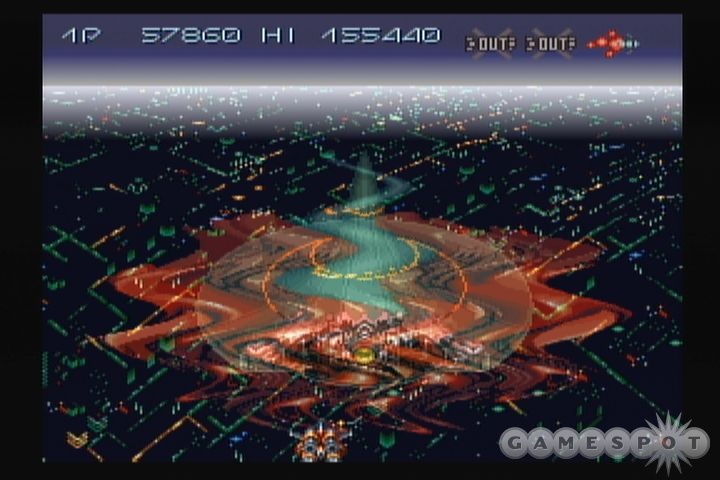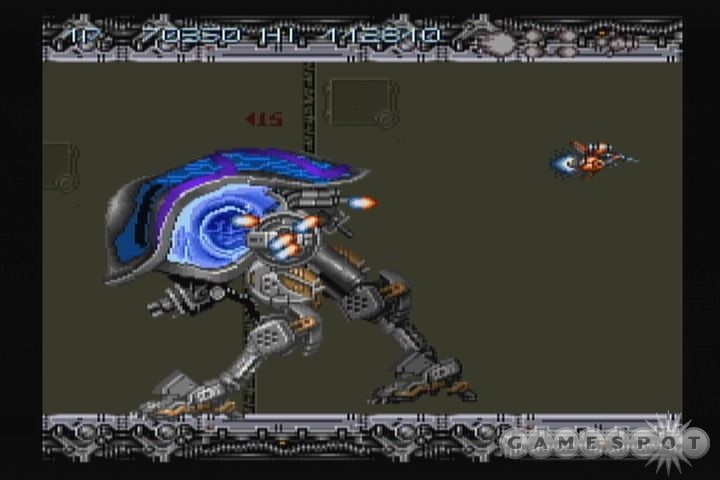When two-dimensional space shooters were in their heyday, almost any game you'd see was similar to the next. A ship flies across a horizontally or vertically autoscrolling background while collecting power-ups, dodging a mess of bullets to avoid one-hit kills, and holding down the "fire" button. Konami tried to do something different with Axelay for the SNES, while at the same time pushing the hardware to its limit. Download its rerelease from the Wii's Virtual Console service today and you'll find that, despite small issues that haven't quite withstood the test of time, Axelay is still a wild ride.

The first thing about Axelay to jump out at you will likely be the presentation, and for good reason: It's the most noticeable thing that sets it apart from its contemporaries. Borrowing an idea from Life Force, another Konami shooter, Axelay delivers both vertical- and side-scrolling levels. The design of the side-scrolling levels is pretty standard, albeit with nice visual details such as the floating remains of destroyed structures. However, the vertical-scrolling levels are set atop Mode 7 and parallax scaling effects, which create a "behind the ship" perspective. The backgrounds, including misty clouds and craterous planet surfaces, seem to rush both at and underneath you. Enemies come in all shapes, sizes, and designs, with special effects such as transparencies and ripple-warping that make for gorgeous encounters.
The pseudo-3D effects applied to the vertical-scrolling levels come with a price. Although the game performs smoothly most of the time, the collision detection isn't as consistent. Sometimes it'll be quite lenient in letting your wings clip some floating barriers without suffering a hit. At other times, enemy fire that just barely nicks those same wings will send your ship rocking from the impact. Sometimes enemy ships will "warp in" via transparency effects, and it's very tough to discern when they'll become completely "solid"--don't be surprised if you're caught off guard by this and lose a life. These days the "wow" factor of Axelay wears off quickly on those more accustomed to shiny polygonal visuals, and it's not as easy to overlook such small issues as it was in the past.
Regardless, it's easy to tell that Axelay was a technical marvel when it was released, and it still looks very pretty. The music is just as fantastic, though in a more subtle way. The compositions go beyond the fast-paced sci-fi themes that you might expect from a space shooter to change things up with slower tempos for some tracks and--oddly--somewhat jazzy themes for others. The end result is a unique soundtrack that works really well with the visuals, even if it seems as if it shouldn't.
Axelay's gameplay has a few tricks of its own. Before each level, you select three weapons from an arsenal that you amass as you advance. During the level, you're given access to each of those selections from the get-go and can switch between them on the fly, which eschews the common power-up mechanic. Each weapon is useful in different situations. If you get hit by enemy fire, you don't lose a life outright; instead you lose the ability to fire the weapon currently equipped, and you're left with a substandard peashooter in its place. You'll constantly switch up how you approach your enemies depending on what they're doing, and you'll improvise when your weapon of choice is taken away from you. This makes for memorable battles against the game's huge, diverse bosses. All the while, Axelay doesn't punish you with its difficulty. With a decent amount of practice, you can play the game in its entirety without breaking your controller.

There's a sense of inventiveness to Axelay. If you played it when it was first released, you knew that you were seeing some cool, different ideas that gelled together to make a space shooter that wasn't just another clone. Examine it today, and you'll notice that elements have inspired and been reused in some of the most revered space shooters since that time. With only six brisk stages, the game is disappointingly short, and you'll have to contend with the collision oddities that remind you how old it really is underneath its graphical sheen. If this doesn't bother you, you'll be wise to spend the 800 Wii points on what is otherwise a robust, creative experience.



